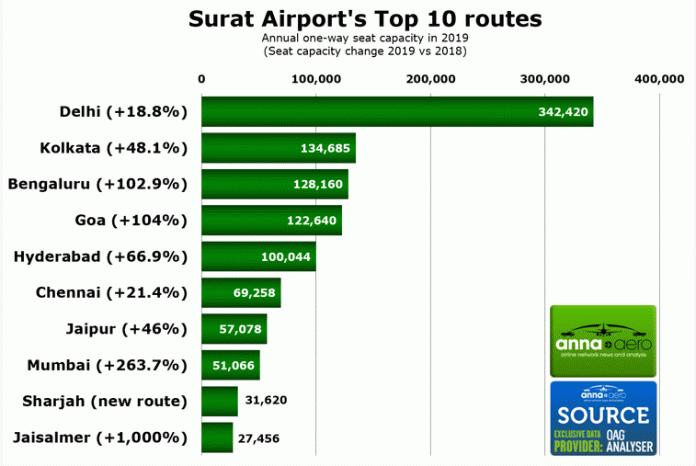When people think of India, they tend to think of the established tourism and commerce hubs: New Delhi, Mumbai, Bangalore, and so on. But it is Surat, a coastal city in the North Western region of Gujurat, that has made recent headlines, with the fastest economic growth of any city on Earth according to a recent Oxford University report. The city’s GDP is projected to grow by 9% per annum between 2019 and 2035, from $29 billion in 2018 to $127 billion in 2035 – bigger than Morocco’s current GDP of $118 billion.
As such, Surat promises to be a key aviation market in years to come. Since 2017, passenger numbers at Surat Airport have more than doubled, an international service has been launched, and low-cost carriers SpiceJet and Indigo have set up rapidly-growing hubs there.
Surat has seen stratospheric passenger growth in recent years, with the peak months of November and December seeing passenger numbers more than double between 2017 and 2018, and every month seeing double-digit growth. September to December is peak season for the airport, with over twice as many passengers passing through its doors in December as April.
The airport’s top routes paint a similar picture. Even established markets, such as capital city Delhi, are experiencing double-digit growth, indicating strengthening demand from a growing number of people able to afford air travel. The World Bank predicts that India’s middle class will grow to 40% of the population, up from 5% in 2007. This means more people can afford to fly, and the fare-reducing effect of LCCs like Indigo and SpiceJet will only increase the potential customer base. Such rapid economic development – particularly in Surat with over 9% GDP growth per year – may explain the remarkable growth of newer routes such as Mumbai and Jaisalmer, with demand increasing tenfold year-on-year

























